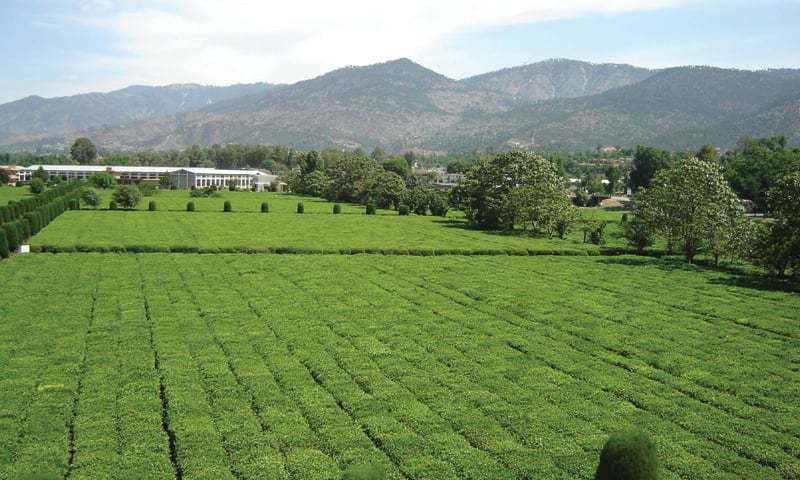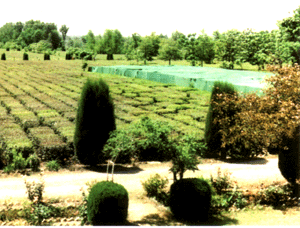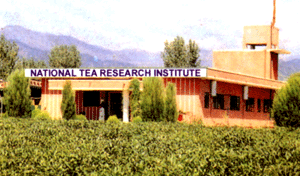ghazi52
PDF THINK TANK: ANALYST

- Joined
- Mar 21, 2007
- Messages
- 101,792
- Reaction score
- 106
- Country
- Location
Tea Plantation in Pakistan
National Tea Research Institute is working under the auspices of Pakistan Agricultural Research Council (PARC) Ministry of National Food Security & Research Islamabad. It has been established in 1986 as National Tea Research Station on 50 acres of land in district Mansehra (Khyber Pakhtunkhwa) and upgraded to the level of Institute in 1996.
A research institute of Mansehra district has found that Pakistan has great potential for producing both black and green tea.
The research was aimed at increasing local tea output so that Pakistan’s dependence on the commodity’s imports could be reduced which stand at around Rs31 billion. The per-capita consumption of tea is estimated to be one kilogram a year.
Pakistan is the third-largest importer of tea in the world. It imports black tea from 19 different countries, with the major share of 60 per cent from Kenya. Green tea is mainly imported from China, Vietnam and Indonesia.
Both green and black tea varieties are processed at the National Tea and High Value Crops Research Institute (NTHRI) in Shinkiari, 18km north of the Mansehra city on the Karakoram highway.
On the recommendations of Chinese tea experts, the National Tea Research Station was set up on 50 acres in Shinkiari with technical assistance from Beijing under the auspices of the Pakistan Agricultural Research Centre (PARC). The aim was to undertake systematic research and promote tea plantation.
Based on the results from the cultivation of Chinese-origin tea crop, the station was upgraded to the level of the institute. The first black tea processing plant started working in 2001 with a daily processing capacity of one tonne.
Research has been conducted with an aim to increase the local output so that the country’s dependence on the commodity’s imports, which stand at around Rs31bn, could be reduced
At the same time, a pilot green-tea processing plant having a daily capacity of 100kg was also procured from China and installed at the Shinkiari institute.
According to officials of the tea research institute, the green and black tea processed at the NTHRI has been tested and analysed at the Hunan Tea Testing Centre and Tenfu Tea College of China.
Speaking about the current status of tea cultivation and its prospects in Pakistan, Director of the National Tea Research Institute Dr Farrukh Siyar Hamid said black tea processed at the NTHRI could not compete with the tea imported from abroad due to its orthodox processing and Chinese germplasm.
Green tea processed at the NTHRI on a small scale gave better response from the consumers in the market. The import and consumption of green tea in Pakistan is low as compared to black tea, which can be achieved within minimum period, he said.
He said that about 64,000 hectares of land has been identified as suitable for tea growing in Mansehra and Swat districts based on topography, soil and climatic data.
In Hazara, the area is located in districts of Mansehra, Battagram and Abbottabad. In Malakand, Swat is a promising area for tea cultivation.
All these areas lie in a fairly contiguous belt, nestled in the foothills of the Hamilayas in the northeast and Hindu Kush in the northwest, Dr Hamid said.
Successful tea plantation has been demonstrated at the institute as well as on fields in potential tea-growing areas of Khyber Pakhtunkhwa and Azad Kashmir. Its yield potential and quality has been assessed to be economically viable and the extent of the area has been identified.
An achievement of the national tea research institute is that exotic tea varieties have been acquired from China, Sri Lanka, Japan and Indonesia.
After screening, 14 varieties were found suitable for the ecological zones and tea gardens of the selected varieties have been established.
The best-known Chinese variety, Keemun, was tested under the environmental conditions of Pakistan, and the growth, production and green tea was found to be successful.
The future plan of the institute is to focus on green-tea processing as the varieties grown at the NTHRI are mainly of Chinese origin. The testing of exotic germplasm suitable for black tea in the potential tea-growing areas will be carried out.
Meanwhile, a pilot black-tea processing plant donated by Turkish state-owned tea-producing company Caykur will be used to process black tea from different varieties grown at the institute, Dr Hamid said.
The plant, which is fully automatic and can produce 400kg to 500kg of tea per day, has reached Karachi port and the documentation for its release is in the pipeline.
National Tea Research Institute is working under the auspices of Pakistan Agricultural Research Council (PARC) Ministry of National Food Security & Research Islamabad. It has been established in 1986 as National Tea Research Station on 50 acres of land in district Mansehra (Khyber Pakhtunkhwa) and upgraded to the level of Institute in 1996.
A research institute of Mansehra district has found that Pakistan has great potential for producing both black and green tea.
The research was aimed at increasing local tea output so that Pakistan’s dependence on the commodity’s imports could be reduced which stand at around Rs31 billion. The per-capita consumption of tea is estimated to be one kilogram a year.
Pakistan is the third-largest importer of tea in the world. It imports black tea from 19 different countries, with the major share of 60 per cent from Kenya. Green tea is mainly imported from China, Vietnam and Indonesia.
Both green and black tea varieties are processed at the National Tea and High Value Crops Research Institute (NTHRI) in Shinkiari, 18km north of the Mansehra city on the Karakoram highway.
On the recommendations of Chinese tea experts, the National Tea Research Station was set up on 50 acres in Shinkiari with technical assistance from Beijing under the auspices of the Pakistan Agricultural Research Centre (PARC). The aim was to undertake systematic research and promote tea plantation.
Based on the results from the cultivation of Chinese-origin tea crop, the station was upgraded to the level of the institute. The first black tea processing plant started working in 2001 with a daily processing capacity of one tonne.
Research has been conducted with an aim to increase the local output so that the country’s dependence on the commodity’s imports, which stand at around Rs31bn, could be reduced
At the same time, a pilot green-tea processing plant having a daily capacity of 100kg was also procured from China and installed at the Shinkiari institute.
According to officials of the tea research institute, the green and black tea processed at the NTHRI has been tested and analysed at the Hunan Tea Testing Centre and Tenfu Tea College of China.
Speaking about the current status of tea cultivation and its prospects in Pakistan, Director of the National Tea Research Institute Dr Farrukh Siyar Hamid said black tea processed at the NTHRI could not compete with the tea imported from abroad due to its orthodox processing and Chinese germplasm.
Green tea processed at the NTHRI on a small scale gave better response from the consumers in the market. The import and consumption of green tea in Pakistan is low as compared to black tea, which can be achieved within minimum period, he said.
He said that about 64,000 hectares of land has been identified as suitable for tea growing in Mansehra and Swat districts based on topography, soil and climatic data.
In Hazara, the area is located in districts of Mansehra, Battagram and Abbottabad. In Malakand, Swat is a promising area for tea cultivation.
All these areas lie in a fairly contiguous belt, nestled in the foothills of the Hamilayas in the northeast and Hindu Kush in the northwest, Dr Hamid said.
Successful tea plantation has been demonstrated at the institute as well as on fields in potential tea-growing areas of Khyber Pakhtunkhwa and Azad Kashmir. Its yield potential and quality has been assessed to be economically viable and the extent of the area has been identified.
An achievement of the national tea research institute is that exotic tea varieties have been acquired from China, Sri Lanka, Japan and Indonesia.
After screening, 14 varieties were found suitable for the ecological zones and tea gardens of the selected varieties have been established.
The best-known Chinese variety, Keemun, was tested under the environmental conditions of Pakistan, and the growth, production and green tea was found to be successful.
The future plan of the institute is to focus on green-tea processing as the varieties grown at the NTHRI are mainly of Chinese origin. The testing of exotic germplasm suitable for black tea in the potential tea-growing areas will be carried out.
Meanwhile, a pilot black-tea processing plant donated by Turkish state-owned tea-producing company Caykur will be used to process black tea from different varieties grown at the institute, Dr Hamid said.
The plant, which is fully automatic and can produce 400kg to 500kg of tea per day, has reached Karachi port and the documentation for its release is in the pipeline.










